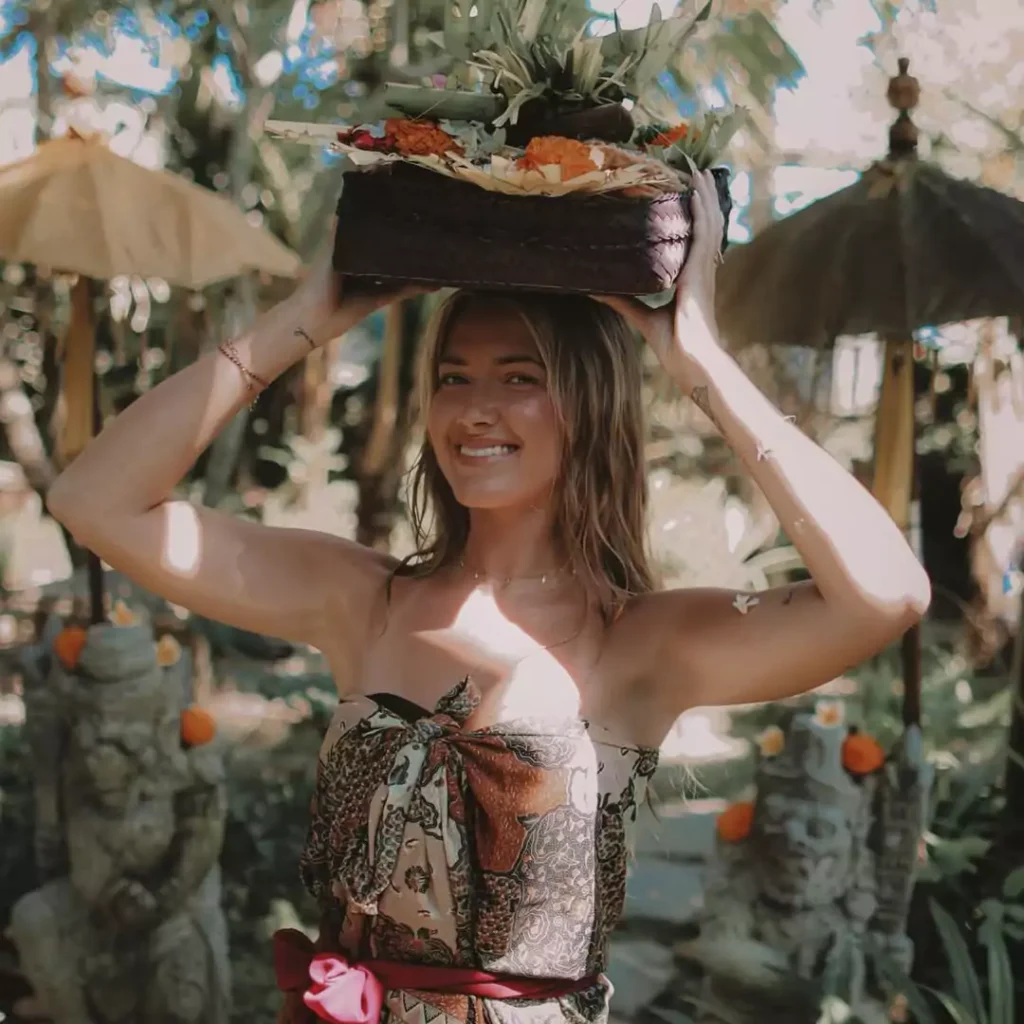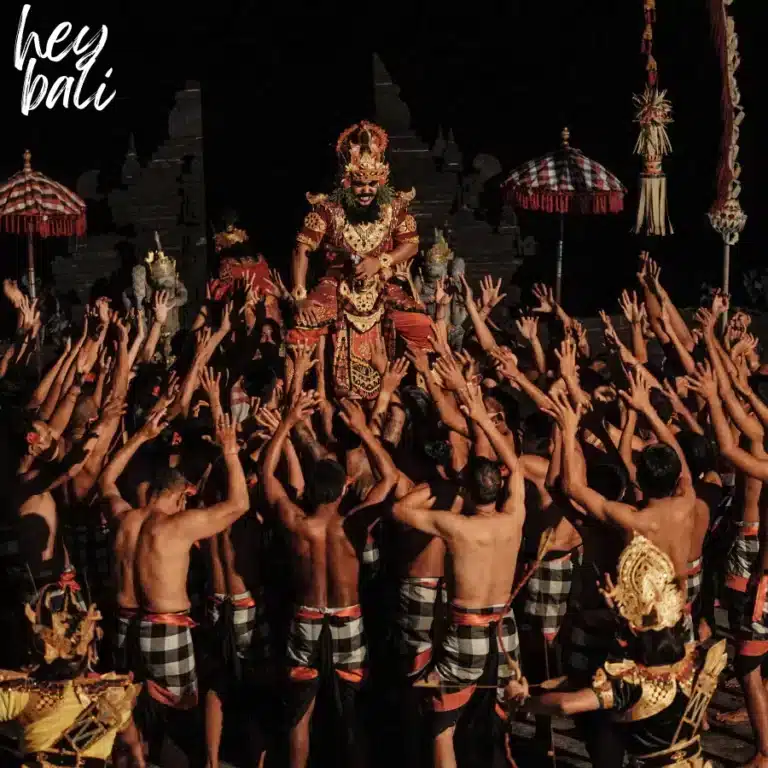Chapters
ToggleDiscover the Deeper Meaning Behind Offerings in Bali—And Why Stepping on Them is a Bigger Oops Than Forgetting Your Sunscreen
You’re walking through the streets of Bali, soaking in the good vibes, when—bam!—a tiny basket of flowers and incense appears right in your path. Then another. And another. Suddenly, you’re in a real-life game of “Don’t Step on the Sacred Offerings” (pro tip: don’t lose).
Meet canang sari—Bali’s daily spiritual love letter to the universe. These vibrant little bundles are more than just eye candy for your Insta feed (though, let’s admit, they definitely deliver on that front).
Balinese offerings like these are an expression of gratitude, a daily ritual to maintain balance between people, nature, and the divine—a core principle known in Bali as Tri Hita Karana.
Hindu offerings in Bali come in many forms and flavors (yes, some include cookies!), and each one carries its own meaning, purpose, and beautifully complex symbolism.
But what’s the deeper story behind these fragrant flower baskets? Who makes them? What do the colors mean? And how do you honor them without accidentally offending the gods while reaching for your phone?
Let’s peel back the layers of tradition, symbolism, and everyday magic behind Bali Hindu offerings. Spoiler: There’s a lot more going on here than just pretty flowers.
〰️🌀〰️🌀〰️🌀〰️
Mini FAQ: Bali Hindu Offerings Explained

Bali Hindu offerings (canang sari) are palm-leaf baskets filled with flowers, incense, and symbolic items. These daily rituals honor gods, ancestors, and nature, maintaining spiritual harmony.
Offerings in Bali appear at sunrise/sunset and during ceremonies. You’ll spot them in temples, homes, and even on scooters—timed to sync with cosmic rhythms.
Follow this sacred order:
Light incense (divine Wi-Fi)
Arrange flowers (color = deity code)
Sprinkle holy water
Add food (gratitude snacks).Follow this sacred order:
Absolutely! Don’t step on them, use your right hand if participating, and snap photos without rearranging. Observe, learn, and vibe with the spirituality.
Beyond their beauty, these offerings in Bali are mindfulness reminders. Those vibrant petals? They’re sacred emojis for the universe. #BlessedAndStyled
These sacred rituals rhythmically structure Balinese life—morning offerings start the day with gratitude, roadside blessings protect commuters, and temple ceremonies unite communities. More than tradition, they’re mindfulness anchors that infuse the island with spiritual harmony visitors can feel.
Now that we’ve covered the basics, let’s dive deeper into the fascinating world of Bali’s offerings—from their sacred ingredients to step-by-step making rituals!
〰️🌀〰️🌀〰️🌀〰️
The Deeper Meaning of Bali Hindu Offerings: Tiny Baskets, Big Wisdom

When in Bali, even the routine is magical. While tourists chase sunsets and smoothie bowls, locals start their days with something far more profound: offerings in Bali. These aren’t just ceremonial flourishes. They’re daily love letters to the universe—woven into the very fabric of Balinese life.
From busy market corners to quiet home shrines, Bali Hindu offerings pop up like spiritual punctuation marks, reminding everyone to slow down and stay connected.
Sure, they look Instagrammable (those flower arrangements are chef’s kiss), but their true beauty lies in their purpose.
Why Bali’s Daily Offerings Are the Ultimate Multitaskers
At first glance, a canang sari might seem like a pretty floral snack for the gods. But dig deeper, and you’ll find it’s a powerhouse of meaning, working overtime on four key levels, as explained in this article on the significance of offerings in Hinduism.
| Aspect | Function |
|---|---|
| Spiritual | A direct hotline to the divine—think of it as a “thank you” note to the universe. |
| Social | Strengthens community bonds (neighbors often prep offerings together). |
| Psychological | A mindfulness hack—crafting them brings calm and focus. |
| Cultural | Keeps ancestral traditions alive, one petal at a time. |
Tri Hita Karana: Bali’s Secret Recipe for Harmony (Spoiler: Offerings Are the Main Ingredient)

Ever wonder why Bali feels so balanced? Meet Tri Hita Karana, the island’s ancient mantra for well-being. Translated as “three causes of happiness,” it’s the philosophy behind offerings in Bali, and it’s all about nurturing three sacred relationships:
- Parahyangan 🤍 Divine Connection
- Those flowers and incense? They’re like cosmic WiFi, keeping the link between humans and gods strong.
- Palemahan 🌿 Nature Love
- Offerings often return to the earth (hello, bird snacks!), reinforcing gratitude for the environment.
- Pawongan 👫 Human Harmony
- Shared rituals = stronger communities. Even tourists get bonus karma points for respecting the process—and the sacred tradition of offerings in Bali
More Than Just Petals: A Mini Life Lesson in Every Basket

Here’s the kicker: Bali Hindu offerings aren’t just about tradition—they’re tiny teachers. Each one whispers:
- Pause. (Put down your phone; the gods prefer incense over Instagram.)
- Give thanks. (Gratitude is the OG wellness trend.)
- Stay connected. (To people, nature, and something bigger than yourself.)
So next time you spot a canang sari, remember: it’s not just decoration—it’s a Bali Hindu offering, and a pocket-sized manifesto for living well—Bali’s way.
✅Pro Tip: Want to level up your Bali vibe? Take a cue from the offerings: slow down, appreciate the little things, and never step on sacred flower confetti. 🙏✨
🙏Read : Gods, Rituals & Offerings: What Religion in Bali Really Looks Like
〰️🌀〰️🌀〰️🌀〰️
Bali Hindu Offerings: A Divine Menu from Daily Snacks to Spiritual Banquets
Think of offerings in Bali like a cosmic catering service—some are quick “good morning” texts to the gods, while others are full five-course spiritual feasts. Let’s explore this sacred lineup, from humble canang sari to show-stopping banten that’d put any wedding buffet to shame.


1. Canang Sari: The Daily “Hey, Thanks for Existing” Basket
Where you’ll spot them: Everywhere. Literally. Sidewalks, scooters, store counters—even on your Gojek driver’s dashboard.
These petite palm-leaf baskets are the MVP of Bali Hindu offerings. Packed with flowers (each color representing a different deity), incense, and sometimes a cheeky cookie, they’re like:
- 🌸 Divine DMs: A daily gratitude ping to the universe
- ⚖️ Balance reminders: Keeping the cosmic scales even
- 📸 Instagram’s favorite subject: #NoFilter needed
Fun fact: The word sari means “essence”—so these little guys pack big spiritual meaning in a tiny package.

2. Banten: When the Gods Get a Michelin-Star Spread
Occasion: Temple anniversaries, weddings, “we really need blessings ASAP” moments
If offerings in Bali had a VIP section, banten would be lounging there with a coconut cocktail. These elaborate, multi-tiered creations feature:
- 🍍 Fruit skyscrapers: Pineapple pagodas, banana leaf bling
- 🎂 Ceremonial cakes: Because even deities appreciate dessert
- 🎨 Next-level artistry: Handwoven palm leaves, flower mandalas
Each element symbolizes something—like how a mango might represent prosperity, or a rice mound echoes Mount Agung. It’s like edible poetry.
Basically, if gods had Instagram, banten would be their #FoodGoals.

3. Sesajen: Room Service for Ancestors & Invisible Neighbors
Recipients: Ancestors, spirits, and those who vibin’ in another dimension
These offerings are less “pretty basket” and more “we see you, we honor you” care packages.
Typical contents include:
- ☕ Coffee/tea: Ancestors deserve a caffeine fix too
- 🍚 Rice & salt: The ultimate Balinese hospitality combo
- 💎 Family heirlooms: “Grandpa loved this pocket watch…”
Placed at crossroads or home shrines, sesajen maintain harmony between realms. Pro tip: If you feel a sudden chill near one? That’s just spirit appreciation.

4. Pejati: The Universe’s Permission Slip
When used: Before building houses, starting projects, or basically any big life move
Ever send a “just checking this is cool?” text before making plans? Pejati are the spiritual version. Simple but mighty, they include:
These offerings are less “pretty basket” and more “we see you, we honor you” care packages.
Typical contents include:
- 🌿 Betel leaves: Ancient Balinese emoji for “respect”
- 🍊 Citrus fruits: For purity and fresh starts
- 🙏 A whole lot of intention: “Dear Universe, pls approve this visa application.
Bali Hindu Offerings: Cheat Sheet
| Type | Purpose | Key Ingredients |
|---|---|---|
| Canang Sari | Daily gratitude | Flowers, incense, smiles |
| Banten | Big ceremonies | Fruit towers, cake, artistic flexing |
| Sesajen | Ancestor shoutouts | Food, drinks, sentimental items |
| Pejati | Cosmic permission slips | Betel leaves, fruit, hopeful vibes |
Why This Matters: More Than Just Petals & Incense
Offerings in Bali aren’t religious decor—they’re a living language of:
- Connection (to gods, nature, and each other)
- Gratitude (even for the small stuff)
- Artistry (Balinese hands turn devotion into beauty)
So next time you see a canang sari on a motorbike or a banten towering in a temple, remember: you’re glimpsing a culture where spirituality isn’t practiced—it’s lived, one flower at a time.
Final Thought:
“In Bali, even the gods get daily deliveries. Talk about premium service.” 🌺✨
🙏Read : Suksma, Bali! How to Say Thank You Like a Local (Without Accidentally Ordering Soup)
〰️🌀〰️🌀〰️🌀〰️
Bali Hindu Offerings: Decoding the Divine Ingredient List

Ever peeked inside a canang sari and wondered, “Is this a snack for gods or the most aesthetic salad ever?” Spoiler: It’s both. Let’s unpack the sacred starter kit behind offerings in Bali—where every petal, leaf, and coin is a VIP guest at the spiritual party.
These sacred components are the soul of Bali Hindu offerings, each one whispering ancient meanings that connect daily life with divine realms.
🌸 Flowers: The Deity DM Slide
Bali’s blooms aren’t just pretty—they’re loaded with meaning. Meet the floral A-listers:
| Flower | Color Code | Deity Hotline |
|---|---|---|
| Frangipani | White | Iswara (East) |
| Hibiscus | Red | Brahma (South) |
| Rose | Pink | Mahadeva (North) |
| Cempaka | Yellow | Vishnu (West) |
Pro tip: Spot a flower facing up? That’s for the gods. Facing down? For earth spirits. Even petals have directional etiquette.
🌿 Bali Hindu Offerings: Leaves as Nature’s Sacred Scaffolding
These green MVPs do the heavy lifting:
- Banana leaves: The OG plate (biodegradable and blessed).
- Coconut leaves (janur): Folded into baskets like spiritual origami.
- Pandan leaves: The “Eau de Sacred Space” air freshener.
Fun fact: The number of leaf layers can signify the offering’s purpose—like spiritual bullet points.

🍍 Bali Hindu Offerings: Food & Fruit as Cosmic Room Service
The gods get fed in style. Menu highlights:
- Rice mounds: Symbolizing Mount Agung (and carb-loaded blessings).
- Salt: For flavor and protection against bad vibes.
- Jajan Bali (cakes): Because divinity deserves dessert.
Snack hack: If ants invade an offering? It’s cool—they’re just the gods’ cleanup crew.
🕯️ Bali Hindu Offerings: Incense + Holy Water as the Spiritual Soundtrack
- Dupa (incense): Smoke signals to the heavens. “Prayer sent ✅”
- Tirta (holy water): Blessed H₂O for purification. Think of it as cosmic Febreze.
Pro move: Watch how smoke curls—if it dances upward, your prayers are definitely getting delivered.

🪙 Bali Hindu Offerings: Uang Kepeng as Ancient Crypto for Good Vibes
These Chinese coins (with a square hole!) aren’t loose change—they’re abundance tokens:
- Stacked: Wealth multiplier.
- Facing east: Sunrise = fresh blessings.
Meme-worthy metaphor: Like Venmo-ing the universe, but with 12th-century aesthetics.
📋 The Sacred Ingredient Cheat Sheet
| Element | Spiritual Emoji | Why It’s There |
|---|---|---|
| Flowers | 🌸 | Deity GPS + beauty |
| Leaves | 🌿 | Structure + purity |
| Rice/Fruit | 🍚 | Gratitude buffet |
| Incense/Water | 🕯️💧 | Prayer delivery |
| Uang Kepeng | 🪙 | Good fortune IOU |
Why This Rocks:
Offerings in Bali are like edible art projects with a PhD in philosophy. They whisper:
- “Thank you” (to nature, gods, and ancestors)
- “We’re listening” (to the universe’s subtler frequencies)
- “Here’s my heart—wrapped in a banana leaf.”
Final Thought:
“In Bali, even a grain of rice has a backstory—and that’s the magic.”
🙏Read : Bali Island: The Ultimate Travel FAQ (100 Answers for Tourists)
〰️🌀〰️🌀〰️🌀〰️
Sacred DIY: How to Craft Your Own Bali Hindu Offering (Without Accidentally Offending the Universe)

Ever walked past a colorful little basket on the street in Bali and thought,
“Is this a snack for gods, a tiny art installation, or both?”
Correct answer: all of the above.
Creating offerings in Bali—like the iconic canang sari—is part art, part prayer, and 100% intention. Whether you’re a curious traveler, a spiritual rookie, or just into sacred aesthetics, here’s your foolproof, respectful guide to crafting your own Balinese offering.
🛍️ The Spiritual Shopping List
Before you channel your inner Balinese grandma, gather these holy essentials:
| Ingredient | Purpose | Pro Tip |
|---|---|---|
| Banana/coconut leaves | Sacred “plate” | Use fresh, flexible leaves for easy folding |
| Assorted flowers | Deity hotline (color = direction) | White for purity, red for energy |
| Incense (dupa) | Prayer delivery system | Sandalwood = classic divine DM |
| Rice grains | Symbol of life & prosperity | Uncooked, please—no sushi offerings 🙃 |
| Betel nut or candy | Ancestor appeasement | Like leaving cookies for Santa—holier |
Optional upgrades:
- 🪙 Uang kepeng (ancient coins = spiritual crypto)
- 🍊 Citrus slices (because gods deserve vitamin C too)
🎋 Step-by-Step: Crafting Canang Sari Like a Pro
1. Leaf Origami 101
Fold banana or coconut leaf into a ~10cm square basket.
Too fiddly? Markets sell ready-made ones—no divine judgment here.
Hack: Secure corners with toothpicks. Even the gods appreciate a good lifehack.
2. Flower Feng Shui
Arrange the flowers like a spiritual compass:
- East (white): Iswara – wisdom
- South (red): Brahma – creation
- West (yellow): Vishnu – preservation
- North (pink/blue): Shiva – transformation
“Think of it as GPS for your blessings.”
3. The Final Touch
Place a lit dupa (incense) in the center.
Watch the smoke curl upward—like a divine TikTok upload.
Sprinkle tirta (holy water) while offering a sembah (prayer hands). And that’s it—you just made spiritual WiFi.
🔥 Beyond Basic Baskets: Next-Level Offerings
Wanna go pro? Try these sacred flexes:
- Janur artistry: Fold coconut leaves into birds, temples, or dragons.
(YouTube = your new digital mentor) - Symbolic layering: Add rice mounds for mountains, salt for protection, petals for intention.
- Sacred soundtrack: Whisper “Om Shanti” as you fold. Instant soul boost.
🙏 Why This Isn’t Just Craft Hour

Making Bali Hindu offerings isn’t just ritual—it’s:
- 🧘 Active meditation: Each fold, each flower, is a mindful moment.
- 🌾 Gratitude in 3D: A way of saying “thank you” to nature, deities, and ancestors.
- 🌺 Cultural soul glue: A tiny basket that holds generations of devotion.
“Perfection isn’t the point—presence is. Crooked flowers? The gods prefer ‘authentic.’”
⚠️ Sacred Etiquette: Don’t Offend the Universe
- 🚫 Never step over an offering (yes, even if it’s in your Airbnb doorway).
- ✋ Use your right hand when placing items (left = spiritually impolite).
- ♻️ Dispose with care—let nature reclaim it or return it to a temple.
🌿 Final Thought
“In Bali, even a clumsily folded leaf basket carries love.”
Start small. Start sincere. The gods speak effort, not perfection.
And in a world chasing aesthetic, these humble offerings whisper something deeper:
Connection. Devotion. Presence.
🙏Read : 45 Amazing Facts About Bali: A Complete Guide to the Island’s Secrets
〰️🌀〰️🌀〰️🌀〰️
When & Where to Offer in Bali: Divine Timing 101 (So You Don’t Accidentally Bless a Parking Lot)
You’ve mastered making Bali Hindu offerings—now where do you put them? Timing and placement matter almost as much as the offering itself. Get it right, and you’re syncing with Bali’s spiritual rhythm. Get it wrong, and… well, let’s just avoid confused locals side-eyeing your “creative” offering spot.
Here’s your sacred GPS for offerings in Bali—from home shrines to scooter dashboards.
🏠 Home Sweet Sacred Space: Daily Offering Hotspots
In Bali, homes have their own spiritual ZIP codes. Meet the holy real estate:
| Location | Offering Schedule | Pro Tip |
|---|---|---|
| Sanggah/Merajan (family temple) | Sunrise & sunset | Morning = fresh start, evening = gratitude |
| Kitchen shrine | Before cooking | Bless your nasi goreng into greatness |
| Gate/entrance | Daily | Spiritual “welcome mat” for good vibes |
Why it matters: These daily offerings in Bali are like checking your spiritual inbox—”sent with love” to ancestors and gods.
🛕 Temple Offerings: RSVP for the Cosmic Party

Balinese temples (pura) are where Hindu offerings in Bali go big. Mark these cosmic celebration dates:
- Odalan: Temple birthdays (think: spiritual Coachella with flower towers)
- Purnama/Tilem: Full & new moons (extra charge in the cosmic atmosphere)
- Galungan/Kuningan: Victory of good over evil (10-day spiritual marathon)
Etiquette alert:
- Wear a sash and sarong—no exceptions.
- Offer with your right hand (left = toilet hand in Balinese culture).
📅 Sacred Calendar: When the Gods Get Extra Attention
Some holy days in the Balinese Hindu calendar are spiritually high-voltage:
| Holy Day | What’s Offered | Vibe Check |
|---|---|---|
| Nyepi Eve | Giant ogoh-ogoh monsters + big offerings | Purge bad energy before silence day |
| Saraswati | Book offerings (yes, textbooks count) | Wisdom > WiFi for a day |
| Siwaratri | All-night Shiva devotion | Coffee-fueled prayers encouraged |
Pro tip: Nyepi = no offerings (even Instagram goes dark).
🌆 Public Offerings: Blessing the Everyday
In Bali, the sacred spills into streetscapes. Spot offerings in Bali at:
- Roadside shrines (pelinggih): Spiritual traffic cops warding off bad luck
- Shop counters: Retail therapy meets karma points
- Scooter dashboards: Because even Grab drivers need divine GPS
Golden rule: Never step over them—walk around like they’re lava.
🙏 Why This Isn’t Just About Logistics
Placing Bali Hindu offerings is:
- Syncing with nature’s clock (sunrise = fresh starts, moon phases = reflection)
- Weaving sacred into mundane (even your 7-Eleven has a shrine)
- Honoring invisible neighbors (spirits, ancestors, and the occasional hungry ant)
“In Bali, you don’t just ‘schedule’ devotion—you live it.” – Giostanovlatto
🌺 Final Thought
“The best offerings in Bali aren’t perfect—they’re present. A wilted flower offered sincerely beats a flawless basket placed carelessly.”
〰️🌀〰️🌀〰️🌀〰️
The Right Way to Offer: Bali Ritual Etiquette (Without Looking Like a Clueless Tourist)


So you’ve got your canang sari ready and know where to place it—but wait! Before you channel your inner high priestess, let’s talk how to offer in Bali without looking like a tourist who confused a shrine for a snack table. Here’s your divine playbook for nailing Bali Hindu offerings like you were born in a Balinese compound.
🧘♀️ Holy Posture 101: Sitting Like You Mean It
Forget yoga class—this is spiritual ergonomics. When making offerings in Bali, your body is part of the prayer:
- Cross-legged (but make it elegant): No slouching—imagine a string pulling your head to the heavens.
- Hands in anjali mudra: Palms pressed together at heart center (like a permanent “thank you” gesture).
- Gaze soft-focused: Think “contemplative” not “contact lens irritation.”
- Head slightly bowed: The universal “I come in peace” body language.
Pro tip: If your knees scream before your prayer does, it’s okay to sit on a small stool. The gods understand arthritis.
🔊 Mantra Matters: Sound On, Ego Off
Once your posture says “present and sacred,” it’s time to activate your inner sound system.
Chanting is not about volume—it’s about vibration. When you speak a mantra in a Bali ritual, you’re tuning into frequencies the gods pick up on (no WiFi needed).
- Speak slowly, clearly, and with intention
- Focus on meaning, not just memorization
- Follow traditional rhythms if you know them—or just speak from the heart
“A whispered mantra in devotion beats a perfect chant done distracted.”
🔥 Offer Like You Know What You’re Doing: Ritual Order 101
There is an order, and yes, the gods do notice when you light the incense last. Here’s your cheat sheet for the symbolic order of offerings in Bali:
- Incense (dupa) — Clears the space energetically
- Flowers — Beauty, sincerity, and color-coded blessings
- Holy water (tirta) — Purifies the moment
- Food or snacks — Gratitude for abundance
“It’s not about perfection. It’s about presence—in the right order.”
🌸 After the Offering: What to Do When the Smoke Clears
You’ve placed your offering, the incense is rising, and now what? Don’t just bounce—rituals in Bali include a graceful exit.
- Stay seated a few extra moments—reflect, breathe, be
- Receive tirta (holy water) and place flower petals on your head = divine approval
- Clean up respectfully—don’t leave trash for the spirits
- Walk away calmly, like you just dropped off a message to the universe (because you did)
“Your last impression matters—even in the spirit realm.”

🪷 Final Thought
Bali Hindu offerings aren’t just actions—they’re mini meditations. From the way you sit to the order you place things, it’s all part of weaving the sacred into the everyday.
“In Bali, the gods aren’t grading your technique—they’re reading your sincerity. Sit well. Speak softly. Offer humbly. That’s the real ritual.”
🙏Read : 10 Myths About Bali Tourists Always Get Wrong
〰️🌀〰️🌀〰️🌀〰️
Why Bali’s Offerings Are the Island’s Spiritual WiFi (And No, They’re Not Just for Your Feed)

Let’s cut to the chase: those Insta-famous Bali Hindu offerings you’ve been double-tapping? They’re not just flower confetti for your vacation pics. They’re the island’s ancient life hack for staying spiritually woke in a modern world.
Here’s why offerings in Bali are the secret sauce you never knew you needed.
🌿 The Spiritual Operating System of Bali
Imagine if your daily routine included:
- Morning gratitude pop-ups (instead of email notifications)
- Cosmic check-ins (no app required)
- Ancestral group chats (read receipts: always on)
That’s essentially what offerings in Bali do. Every canang sari is a:
- ✅ Mindfulness reminder (put down your phone, pick up some petals)
- ✅ Karma booster (good vibes direct deposit)
- ✅ Cultural baton (passed down for 1,000+ years and counting)
“In Bali, even sidewalks pray. Maybe that’s why the air feels different here.”
🔮 More Than Petals: A Crash Course in Cosmic Logistics
Breakdown of what you’re really looking at:
| Element | Surface-Level | Secret Spiritual Hack |
|---|---|---|
| Flowers | “Pretty colors!” | GPS coordinates for specific deities |
| Incense | Nice smell | Divine DM delivery system |
| Rice grains | Tiny carbs | Mini Mount Agungs (abundance symbols) |
| Palm leaf base | Eco-friendly tray | Earth’s charging pad for blessings |
Fun fact: The average Balinese woman makes 15+ offerings daily. That’s 5,000+ per year. Your one gym session this week suddenly seems less impressive.
📶 Why Tourists Get a Free Signal Boost
Here’s the magic—you don’t need to be Balinese to benefit from Bali Hindu offerings. Just by:
- Not stepping on them (basic respect = good karma)
- Pausing to admire (you’re now part of the energy exchange)
- Understanding their purpose (translation: you’re no longer that clueless tourist)
“Offerings in Bali work like spiritual WiFi—you don’t need the password to feel the connection.”

📸 For the ’Gram vs. For the Soul
Yes, they’re photogenic. No, that’s not the point—but here’s how to ’gram responsibly:
✅ Do:
- Shoot from a low angle (flowers > your feet in the frame)
- Tag #SacredNotStaged
- Leave a silent “thank you” in your heart
❌ Don’t:
- Move offerings for better lighting (the gods have influencers blocked)
- Pose like it’s Coachella (this isn’t a flower crown moment)

🌺 The Takeaway: Bali’s Open-Source Spirituality
What makes offerings in Bali next-level:
- They’re free to observe (no temple entry fee required)
- They’re always “on” (24/7 blessings with no off-season)
- They’re the ultimate cultural immersion (no phrasebook needed)
“In a world of spiritual paywalls, Bali’s offerings are like an open-source code for harmony.”

🪔 Final Challenge
Next time you see a canang sari:
- Stop (literally—don’t walk over it)
- Breathe (inhale that incense + intention)
- Think (“What am I grateful for today?”)
Congrats! You just tapped into Bali’s secret network. No login required.
🙏Read : Cheap Bali Sim Card and Esim Start From $9 For 30 Days
〰️🌀〰️🌀〰️🌀〰️
Final Conclusion : Bali Hindu Offerings

Bali’s Offerings: Where Every Petal Tells a Story
From the humble canang sari to towering banten, Bali Hindu offerings are more than rituals—they’re the island’s living poetry. Each flower, each grain of rice, whispers a truth: that gratitude, balance, and connection are the real magic behind Bali’s charm.
Now that you’ve uncovered their secrets, why not go deeper?
✨ Become Balinese for a Day ✨

Immerse yourself in the art of offerings in Bali with our authentic local experience:
- Craft & offer canang sari with a Balinese grandmother
- Join a melukat purification ritual at a hidden water temple
- Feast at a locals-only warung (where the flavors are as rich as the stories)
- Decode Bali’s soul at Museum Bali with a cultural guide
Limited to small groups. DM “OFFERING TOUR” to book your sacred adventure!
Final Thought:
“In Bali, offerings are like Wi-Fi: invisible, but essential for connection. What are you offering to tune into the island’s frequency today?” – Giostanovlatto🌺
〰️🌀〰️🌀〰️🌀〰️

Meet the Author
Giostanovlatto is a self-proclaimed “professional wanderluster” who believes that life is too short to stay in one place. When he’s not busy chasing sunsets or hunting for the best local food, you can find him striking up conversations with strangers (who often become friends by the end of the trip).










































































